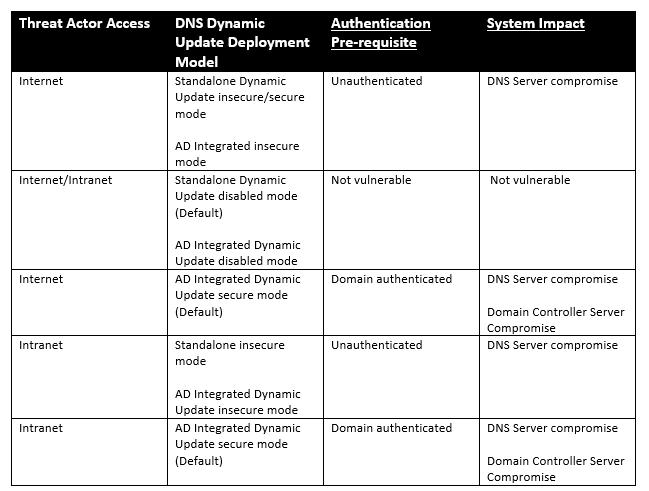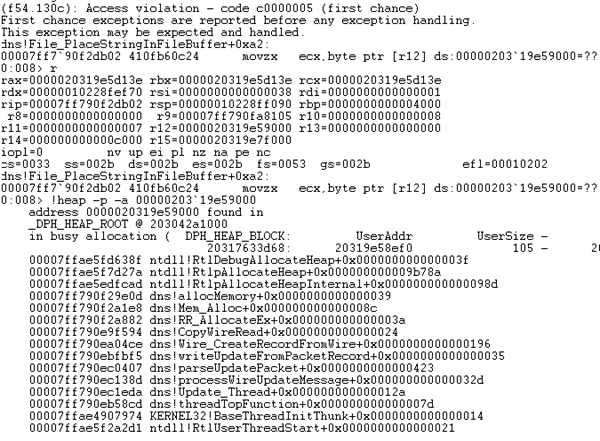Blogs
The latest cybersecurity trends, best practices, security vulnerabilities, and more
ARCHIVED STORY
Seven Windows Wonders – Critical Vulnerabilities in DNS Dynamic Updates
Eoin Carroll · MAR 09, 2021
Overview
For the March 2021 Patch Tuesday, Microsoft released a set of seven DNS vulnerabilities. Five of the vulnerabilities are remote code execution (RCE) with critical CVSS (Common Vulnerability Scoring Standard) scores of 9.8, while the remaining two are denial of service (DoS). Microsoft shared detection guidance and proofs of concept with MAPP members for two of the RCE vulnerabilities, CVE-2021-26877 and CVE-2021-26897, which we have confirmed to be within the DNS Dynamic Zone Update activity. Microsoft subsequently confirmed that all seven of the DNS vulnerabilities are within the Dynamic Zone Update activity.
We confirmed from our analysis of CVE-2021-26877 and CVE-2021-26897, in addition to further clarification from Microsoft, that none of the five DNS RCE vulnerabilities are wormable.
RCE vulnerabilities
CVE-2021-26877, CVE-2021-26897 (exploitation more likely)
CVE-2021-26893, CVE-2021-26894, CVE-2021-26895 (exploitation less likely)
DoS vulnerabilities
CVE-2021-26896, CVE-2021-27063 (exploitation less likely)
A critical CVSS score of 9.8 means that an attacker can remotely compromise a DNS server with no authentication or user interaction required. Successful exploitation of these vulnerabilities would lead to RCE on a Primary Authoritative DNS server. While CVSS is a great tool for technical scoring, it needs to be taken in context with your DNS deployment environment to understand your risk which we discuss below.
We highly recommend you urgently patch your Windows DNS servers if you are using Dynamic Updates. If you cannot patch, we recommend you prioritize evaluating your exposure. In addition, we have developed signatures for CVE-2021-26877 and CVE-2021-26897 which are rated as “exploitation more likely” by Microsoft.
DNS Dynamic Updates, Threats and Deployment
Per the NIST “Secure Domain Name System (DNS) Deployment Guide”, DNS threats can be divided into Platform and Transaction Threats. The platform threats can be classed as either DNS Host Platform or DNS Software Threats. Per Table 1 below, Dynamic Update is one of the four DNS Transaction types. The seven DNS vulnerabilities are within the Dynamic Update DNS transaction feature of Windows DNS Software.

Table 1: DNS Transaction Threats and Security Objectives
The DNS Dynamic Zone Update feature allows a client to update its Resource Records (RRs) on a Primary DNS Authoritative Server, such as when it changes its IP address; these clients are typically Certificate Authority (CA) and DHCP servers. The Dynamic Zone Update feature can be deployed on a standalone DNS server or an Active Directory (AD) integrated DNS server. Best practice is to deploy DNS integrated with (AD) so it can avail itself of Microsoft security such as Kerberos and GSS-TSIG.
When creating a Zone on a DNS server there is an option to enable or disable DNS Dynamic Zone Updates. When DNS is deployed as a standalone server, the Dynamic Zone Update feature is disabled by default but can be enabled in secure/nonsecure mode. When DNS is deployed as AD integrated, the Dynamic Zone Update feature is enabled in secure mode by default.
Secure Dynamic Zone Update verifies that all RR updates are digitally signed using GSS-TSIG from a domain-joined machine. In addition, more granular controls can be applied on what principal can perform Dynamic Zone Updates.
Insecure Dynamic Zone Update allows any machine to update RRs without any authentication (not recommended).
Attack Pre-requisites
- AD Integrated DNS Dynamic Updates (default config of secure updates)
- A DNS server must accept write requests to at least one Zone (typically a primary DNS server only allows Zone RR writes but there are misconfigurations and secondary servers which can negate this)
- Domain-joined machine
- Attacker must craft request to DNS server and supply a target Zone in request
- Standalone DNS Server (secure/nonsecure config)
- A DNS server must accept write requests to at least one Zone (typically a primary DNS server only allows Zone RR writes but there are misconfigurations and secondary servers which can negate this)
- Attacker must craft request to DNS server and supply a target Zone in request
From a Threat Model perspective, we must consider Threat Actor motives, capabilities, and access/opportunity, so you can understand the risk relative to your environment. We are not aware of any exploitation in the wild of these vulnerabilities so we must focus on the access capabilities, i.e., close the door on the threat actor opportunity. Table 2 summarizes DNS Dynamic Update deployment models relative to the opportunity these RCE vulnerabilities present.

Table 2: Threat Actor access relative to deployment models and system impact
The highest risk deployment would be a DNS server in Dynamic Update insecure mode exposed to the internet; this is not best security practice and based on our experience, we do not know of a use case for such deployment.
Deploying AD integrated DNS Dynamic Update in secure mode (default) mitigates the risk of an unauthenticated attacker but still has a high risk of a compromised domain computer or trusted insider being able to achieve RCE.
Vulnerability Analysis
All the vulnerabilities are related to the processing of Dynamic Update packets in dns.exe. The goal of our vulnerability analysis, as always for critical industry vulnerabilities, is to ensure we can generate accurate signatures to protect our customers.
Analysis of CVE-2021-26877
- The vulnerability is triggered when a Zone is updated with a TXT RR that has a “TXT length” greater than “Data length” per Wireshark below:

Figure 1: Wireshark view of exploit packet classifying the DNS packet as malformed
- The vulnerability is in the File_PlaceStringInFileBuffer() function as you can see from WinDbg output below:

Figure 2: WinDbg output of crash while attached to dns.exe
- The vulnerability is an Out of bounds (OOB) read on the heap when the “TXT length” field of DNS Dynamic Zone Update is not validated relative to “Data length”. This could allow an attacker to read up to 255 bytes of memory. Microsoft states this vulnerability can be used to achieve RCE; this would require a further OOB write primitive.
- The memory allocation related to the OOB read is created within the CopyWireRead() function. Relevant pseudo code for this function is below:

- The
File_PlaceStringInFileBuffer()function copies data fromTXT_dataallocated fromCopyWireRead()function previously. However, the UpdateRR->TXT length value from Wireshark is not validated and used to copy from *UpdateRR->Data length. Because UpdateRR->TXT length is not validated relative to UpdateRR->Data length it results in a OOB read from heap memory.
Analysis of CVE-2021-26897
- The vulnerability is triggered when many consecutive Signature RRs Dynamic Updates are sent
- The vulnerability is an OOB write on the heap when combining the many consecutive Signature RR Dynamic Updates into base64-encoded strings before writing to the Zone file
- Microsoft states this vulnerability can be used to achieve RCE

Figure 3: Packet containing many consecutive Signature RR dynamic updates. Pay special attention to the length field of the reassembled flow.
Exploitability
Exploiting these vulnerabilities remotely requires both read and write primitives in addition to bypassing Control Flow Guard (CFG) for execution. The DNS protocol has significant remote unauthenticated attack surface to facilitate generating such primitives which has been researched as part of CVE-2020-1350 (SigRed). In addition, per the RR_DispatchFuncForType() function, there are read and write functions as part of its dispatch table.

Figure 4: Path of DNS RR update packet

Figure 5: Dispatch functions for reading and writing
Mitigations
Patching is always the first and most effective course of action. If it’s not possible to patch, the best mitigation is to audit your DNS deployment configuration to limit Dynamic Zone Updates to trusted servers only. For those McAfee customers who are unable to deploy the Windows patch, the following Network Security Platform (NSP) signatures will provide a virtual patch against attempted exploitation of both vulnerabilities, CVE-2021-26877 and CVE-2021-26897.
NSP Attack ID: 0x4030e700 – DNS: Windows DNS Server Remote Code Execution Vulnerability (CVE-2021-26877)
NSP Attack ID: 0x4030e800 – DNS: Windows DNS Server Remote Code Execution Vulnerability (CVE-2021-26897)
In addition, NIST “Secure Domain Name System (DNS) Deployment Guide” provides best practices for securing DNS deployment such as:
- DNS Primary Server should restrict clients that can update RRs
- Secure Dynamic Update using GSS-TSIG
- Secondary DNS Server Dynamic Update forwarding restrictions using GSS-TSIG
- Fine-grained Dynamic Update restrictions using GSS-TSIG
RECENT NEWS
-
Jun 17, 2025
Trellix Accelerates Organizational Cyber Resilience with Deepened AWS Integrations
-
Jun 10, 2025
Trellix Finds Threat Intelligence Gap Calls for Proactive Cybersecurity Strategy Implementation
-
May 12, 2025
CRN Recognizes Trellix Partner Program with 2025 Women of the Channel List
-
Apr 29, 2025
Trellix Details Surge in Cyber Activity Targeting United States, Telecom
-
Apr 29, 2025
Trellix Advances Intelligent Data Security to Combat Insider Threats and Enable Compliance
RECENT STORIES
Get the latest
Stay up to date with the latest cybersecurity trends, best practices, security vulnerabilities, and so much more.
Zero spam. Unsubscribe at any time.